You searched for: used%E4%BA%A4%E6%98%93%E7%A8%8B%E5%BA%8F%E5%BE%8C%E8%87%BA%E6%BA%90%E7%A2%BC%E3%80%90tg%EF%BF%BD%EF%BF%BD%EF%BF%BD%EF%BF%BD%EF%BF%BD%EF%BF%BD%EF%BF%BD%EF%BF%BD%EF%BF%BD%40ek7676%E3%80%91%E5%B9%B3%E5%8F%B0%E5%8C%85%E7%BD%91%E6%90%AD%E5%BB%BAusd%E4%BA%A4%E6%98%93%E7%A8%8B%E5%BA%8F%E5%BE%8C%E8%87%BA%E6%BA%90%E7%A2%BC%E3%80%90tg%EF%BF%BD%EF%BF%BD%EF%BF%BD%EF%BF%BD%EF%BF%BD%EF%BF%BD%EF%BF%BD%EF%BF%BD%EF%BF%BD%40ek7676%E3%80%91%E5%B9%B3%E5%8F%B0%E5%8C%85%E7%BD%91%E6%90%AD%E5%BB%BAivkcss1pgu
<< Previous | Displaying results 141-150 of 1834 for "used%E4%BA%A4%E6%98%93%E7%A8%8B%E5%BA%8F%E5%BE%8C%E8%87%BA%E6%BA%90%E7%A2%BC%E3%80%90tg%EF%BF%BD%EF%BF%BD%EF%BF%BD%EF%BF%BD%EF%BF%BD%EF%BF%BD%EF%BF%BD%EF%BF%BD%EF%BF%BD%40ek7676%E3%80%91%E5%B9%B3%E5%8F%B0%E5%8C%85%E7%BD%91%E6%90%AD%E5%BB%BAusd%E4%BA%A4%E6%98%93%E7%A8%8B%E5%BA%8F%E5%BE%8C%E8%87%BA%E6%BA%90%E7%A2%BC%E3%80%90tg%EF%BF%BD%EF%BF%BD%EF%BF%BD%EF%BF%BD%EF%BF%BD%EF%BF%BD%EF%BF%BD%EF%BF%BD%EF%BF%BD%40ek7676%E3%80%91%E5%B9%B3%E5%8F%B0%E5%8C%85%E7%BD%91%E6%90%AD%E5%BB%BAivkcss1pgu" | Next >>
-
Large wooden crate used by Żegota to hide false documents
ArtifactThis large, lidded wooden chest was used by the Council for Aid to Jews (codenamed “Żegota”) to hide false identity documents from Nazi authorities. Żegota was an underground rescue organization of Poles and Jews in German-occupied Poland and operated from December 1942 to January 1945. Supported by the Polish government-in-exile, it coordinated efforts to save Jews in German-occupied Poland from Nazi persecution and murder. One of Żegota’s most impactful clandestine activities was producing and…
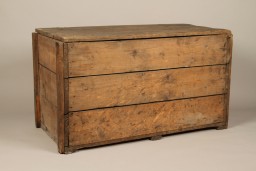
-
Romani (Gypsy) musician's violin used in a prewar musical band
ArtifactViolin owned by Rita Prigmore and originally used by her father, who played with his four brothers in a band in Germany before World War II. Rita and her family were members of the Sinti group of Roma (Gypsies). She and her twin sister Rolanda were born in 1943. Rolanda died as a result of medical experiments on twins in the clinic where they were born. Rita and her mother survived the war and moved to the United States, before returning to Germany to run a Sinti human rights organization that sought to…
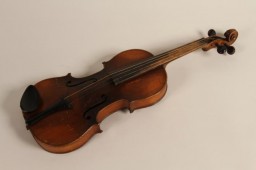
-
Small hooked rug used in the wagon of a Romani (Gypsy) family
ArtifactThis small patterned hooked rug was used as a shoe mat in the wagon of Rita Prigmore and her family when she was a child in Wurzberg, Germany, after World War II. Rita and her family were members of the Sinti group of Roma (Gypsies). She and her twin sister Rolanda were born in 1943. Rolanda died as a result of medical experiments on twins in the clinic where they were born. Rita was returned to her family in 1944. She and her mother survived the war and moved to the United States, before returning to…
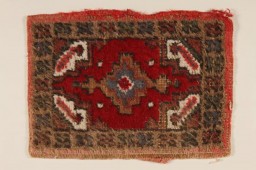
-
Drexel Sprecher describes German documentation that could be used as evidence
Oral HistoryDrexel Sprecher was educated at the University of Wisconsin, the London School of Economics, and at the Harvard School of Law before receiving a position at the US Government's Labor Board in 1938. He enlisted in the American military after the United States declared war on Germany, and was posted to London. After the war, Sprecher served as a prosecutor of Nazi war criminals at the Nuremberg trials.

-
Metal box used to hide contents of the Oneg Shabbat archives
ArtifactOne of the ten metal boxes in which portions of the Ringelblum Oneg Shabbat archives were hidden and buried in the Warsaw ghetto. The boxes are currently in the possession of the Jewish Historical Institute in Warsaw.

-
Three metal boxes used to hold content of the Oneg Shabbat archive
ArtifactThree of the ten metal boxes in which portions of the Oneg Shabbat archive were hidden and buried in the Warsaw ghetto. The boxes are currently in the possession of the Jewish Historical Institute in Warsaw. In this view the three boxes are stacked on top of one another. The box on top is displayed on its side without the lid.
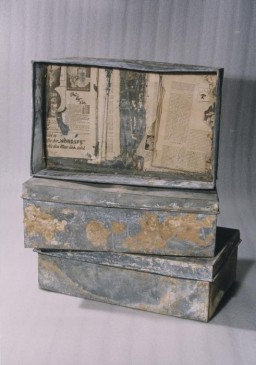
-
Beifeld album page showing houses used as officers quarters
ArtifactIn a drawing dated April 14, 1942, Beifeld shows houses in Csobanka (Szentendre district), Hungary, where the Hungarian military officers assigned to the labor service company were quartered before their departure for the Ukraine. [Photograph #57949]
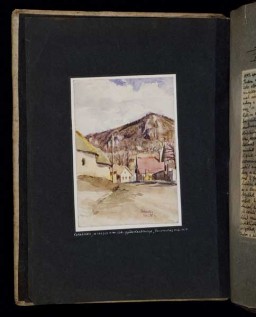
-
Einsatzgruppen trial: US prosecution opens case against Einsatzgruppen members
FilmAfter the trial of major war criminals before the International Military Tribunal in Nuremberg, the United States held a series of other war crimes trials at Nuremberg—the Subsequent Nuremberg Proceedings. The ninth trial before the American military tribunal in Nuremberg focused on members of the Einsatzgruppen (mobile killing units), who had been assigned to kill Jews and other people behind the eastern front. This footage shows US prosecutor Ben Ferencz outlining the purpose of the trial during…
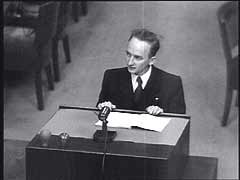
-
US veteran Raymond Buch describes forcing civilians to bury the dead
Oral HistoryAs a US Army sergeant, Raymond fought in the Battle of the Bulge. In May 1945, his unit was deployed to the Mauthausen camp in Austria to bulldoze mass graves for the victims. He watched as German civilians, on US orders, hauled bodies to the mass graves. He also saw stronger camp survivors pull clothes off their weaker counterparts to replace their own tattered uniforms. Raymond went on to Mauthausen's Ebensee camp and Gusen, guarding SS men.

-
David (Dudi) Bergman describes liberation by US Army in mountains near Innsbruck
Oral HistoryThe Germans occupied David's town, previously annexed by Hungary, in 1944. David was deported to Auschwitz and, with his father, transported to Plaszow. David was sent to the Gross-Rosen camp and to Reichenbach. He was then among three of 150 in a cattle car who survived transportation to Dachau. He was liberated after a death march from Innsbruck toward the front line of combat between US and German troops.

